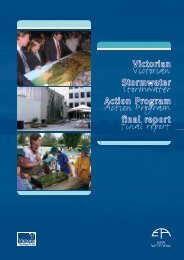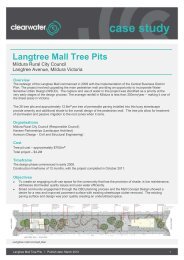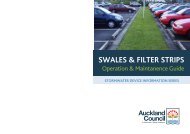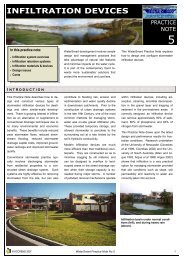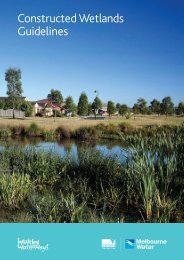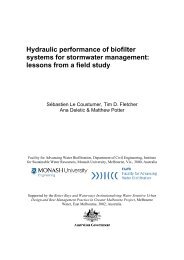CRC Street Sweep Eval 1999.pdf( 489.9 KB ) - Clearwater
CRC Street Sweep Eval 1999.pdf( 489.9 KB ) - Clearwater
CRC Street Sweep Eval 1999.pdf( 489.9 KB ) - Clearwater
Create successful ePaper yourself
Turn your PDF publications into a flip-book with our unique Google optimized e-Paper software.
COOPERATIVE RESEARCH CENTRE FOR CATCHMENT HYDROLOGY<br />
runoff to be associated with particulates. While most<br />
particulate matter found on street surfaces is in the<br />
fractions of sand and gravel. Approximately 6% of<br />
particles are in the silt and clay soil size and they<br />
were found to contain over half the phosphorous and<br />
some 25 percent of other pollutants, as indicated in<br />
Table 6.1, adapted by Shaver (1996) from results of<br />
Sartor et al. (1974).<br />
Many other investigations have found the<br />
concentrations of sediment-bound contaminants in<br />
street dirt to be associated with the fine particle size<br />
fraction. Pitt & Amy (1973), NCDNRCD (1993) and<br />
Woodward-Clyde (1994) have all shown that higher<br />
concentrations of pollutants such as heavy metals are<br />
associated with the smallest particle size fractions of<br />
urban dust and dirt. These data indicate that almost<br />
half of the heavy metals (represented by copper, lead<br />
and zinc) found on street sediments are associated<br />
with particles of 60 to 200 µm in size and 75% are<br />
associated with particles finer than 500 µm in size.<br />
Dempsey et al. (1993) undertook an analysis of<br />
particle size distributions for urban dust and dirt, and<br />
partitioning of contaminants into a number of size<br />
fractions to determine the concentrations of<br />
contaminants in each particle size range. Results<br />
show the highest recorded concentrations of Cu, Zn<br />
and TP to be associated with sand particles between<br />
74 and 250 µm in size.<br />
Colwill et al. (1984) found 70% of oil and<br />
approximately 85% of polycyclic aromatic<br />
hydrocarbon (PAH) to be associated with solids in the<br />
stormwater. That study demonstrated that over a<br />
period of dry weather conditions, increasing<br />
proportions of oil become solid associated where the<br />
highest oil content was found in sediments of 200 to<br />
400 µm in size.<br />
Sansalone et al. (1997), Fergusson and Ryan (1984),<br />
Baker (1980) and Wilber and Hunter (1979) all<br />
reported that heavy metal concentrations increase<br />
with decreasing particle size. Results presented by<br />
Sansalone et al. (1997) from particle size distribution<br />
and metal analysis indicate that zinc, copper and lead<br />
concentrations increase with decreasing particle size<br />
or, equivalently, increasing specific surface area. The<br />
absorption of contaminants to particles is often<br />
regarded as being directly related to the surface area<br />
per unit mass available for ion absorption. Measured<br />
specific surface area results presented by Sansalone et<br />
al. (1997) indicated that the assumption of smooth<br />
spherical particles to estimate available surface area<br />
Table 6.1 Percentage of <strong>Street</strong> Pollutants in Various Particle Size Ranges<br />
Particle Size Particle (Microns) Size (µm)<br />
Pollutant 2000<br />
Total Solids 5.9 9.7 27.8 24.6 7.6 24.4<br />
Volitile Solids 25.6 17.9 16.1 12.0 17.4 11.0<br />
COD 22.7 45.0 12.4 13.0 4.5 2.4<br />
BOD 24.3 17.3 15.2 15.7 20.1 7.4<br />
TKN 18.7 19.6 20.2 20.0 11.6 9.9<br />
Phosphates 56.2 29.6 6.4 6.9 0.9 0.0<br />
All Toxic Metals 27.8 - 23.5 14.9 17.5 16.3<br />
(Source: Shaver; 1990; adapted from Sartor, Boyd, and Agardy, 1974)<br />
17




